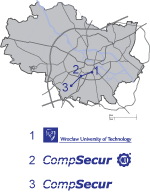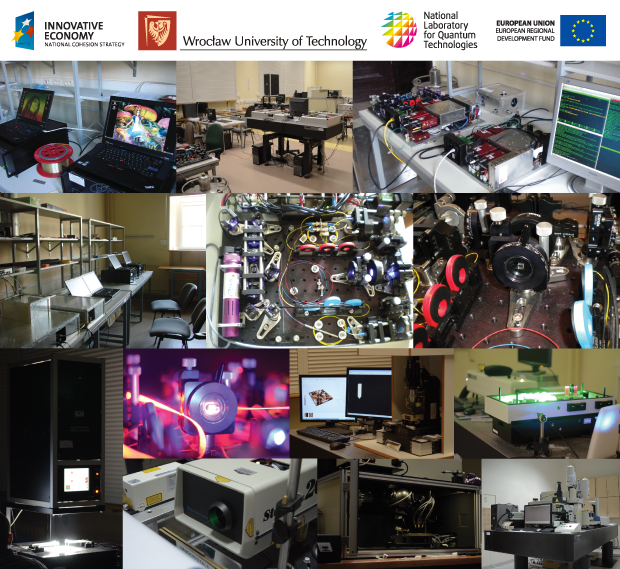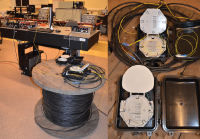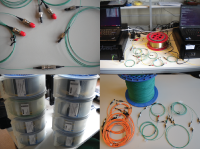Wrocław QKD network

Due to significant investments in Wrocław University of Technology laboratory equipment encompassing current state-of-the-art quantum cryptography technologies within the Polish National Quantum Technologies Laboratory NLTK network programme, as well as technological partnerships with internationally leading vendors of quantum cryptographic systems and national information security institutions and companies, city of Wroclaw now hosts a unique metropolitan quantum network research and development project.
An analysis of the backbone architecture of Wroclaw metropolitan network and its key nodes is carried out towards identifying connections of a highest potential in regard to securing with quantum cryptography (analysis includes classification of the threats on the particular nodes and the connection lines, technical characteristics of optical fibers connecting the backbone network nodes and levels of nodes importance from technical network, business and administration perspective).
National Quantum Technologies Laboratory NLTK, Wrocław University of Technology

Experimental and even early commercial QKD implementations are very susceptible to technical conditionings of the transmitting media (i.e. optical fiber infrastructure and associated alignment of the quantum optics) therefore deployment of QKD systems in real metropolitan optical fiber infrastructure network poses a challenge.


The optical infrastructure is determined by the city telecommunication canalization layout. Dark fibers connecting two, even not very distant metropolitan locations physically sharing an industry-standard telecom line with many parallel fibers (constituting the initial P2P topology and medium for QKD network) are divided in a series of thermally welded interconnections and junctions at telecom canalization crossings, which are main reason for decoherence and quantum signal losses, resulting with increased QBER and with infeasibility of key distribution in practical scenarios (this is specifically addressed to dark fiber infrastructure of metropolitan backbone telecom networks with multiple interconnections of telecommunication optical lines, which are implemented by thermal weldings – a connection between two locations separated by ca. 4-5 km distance, is usually divided by even several fiber weldings)
Research project:
- The project combines industrial and pre-deployment research over practical aspects of decoherence of qubits in quantum channels constituted by different types of optical fibers and standardized telecommunication optical connectors along with technological imperfections of qubit sources and detectors, which together stand as the most fundamental obstacles in practical applications of QKD towards realistic deployments in metropolitan networks combining both the no-entanglement and entanglement based QKD methods as implemented in the project laboratories by the no-entanglement and entanglement based state of the art prototype QKD systems.
- The ongoing research programme includes technical characteristics and conditionings of the entangled and non-entangled qubits sources, channels and detectors for the experimental prototype QKD systems, topological network configurations concepts, authentication problems, development of classical protocols stack responsible for the QKD key sifting, error correction and privacy amplification, network (hardware) and software integration interfaces and proper configuration towards deployment of experimental systems in metropolitan network environments.
Research programme:
- Technical conditioning of non-entangled and entangled quantum information carriers sources, and the possibilities to encode information in QKD systems (laser operation characteristics, parametric down conversion characteristics).
- Decoherence of quantum information carriers in different technical configurations of optical fiber telecommunication networks in non-entanglement and entanglement based QKD prototype systems.
- Technical conditioning of quantum information carriers detection in non-entanglement and entanglement based QKD prototype systems.
- Conditioning of topological configuration of non-entanglement and entanglement based QKD prototype systems in realistic metropolitan fiber optics network environments.
- Quantum cryptographic session authentication problem for non-entanglement and entanglement based QKD prototype systems.
- Development of QKD protocol stack (including classical algorithms of key reconciliation, error correction and privacy amplification) and interface systems.
- Evaluation of commercial backbone telecom networks deployment feasibility of non-entanglement and entanglement based QKD prototype systems.
- Development of technical documentation for installation and configuration of the experimental QKD prototype systems in commercial backbone telecom networks.

Research on QKD prototypes deployment in practical telecommunication network environments resulted in evaluation of boundary conditions for QKD feasibility versus quantum channel and transmission parameters and a successful resolution of channel quality problem by proper alignment of experimental QKD setups. The fiber optics line of the SMF28 standard has been used to test different connection and welding configurations for two QKD prototype approaches based no-entanglement protocols (encoding qubits on interfering phase shifts of laser impulses in Mach-Zehnder interferometers) and the entanglement protocols (encoding qubits on polarizations of entangled photon pairs generated in non-linear PDC process in a BBO crystal). The main optics fiber line (single mode SMF28 standard) has been subsequently modified in laboratory test runs by welded or interconnected F3000/APC and FC/PC adapters. The interconnectors resulted with high QBER increases, thus favoring thermal welding which in proper proximity distribution were characterized by ca. 10 times lower loss induction than interconnectors (ca. 0.01 dB per welding, depending on the proximities). Next the industry standard telecom fiber optics line tests have been carried out towards welding and interconnections configuration optimizing in regard to QBER and conditioning of the metropolitan network deployment. Primary focus was directed towards the non-entanglement based setup which turned out to be operating properly with an acceptable raw key exchange rate (RKER) generating targeted amount of distilled secret bits (DSB) under laboratory simulation of real optic fiber backbone metropolitan network configuration with required optimization of interconnections and welding infrastructure. The entanglement based QKD prototype has been tested for the first time in a real telecom network environment and proved to be also feasible but within a very narrow gap of optical elements alignment and poor values of QBER and RKER with high additional instability of operation parameters, which require further components development (especially in compensation of optical alignment).
 Progress in Quantum Cryptography
Progress in Quantum Cryptography